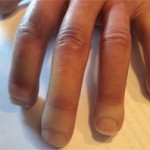“I think so,” Mr. Indura scratched the stubble on his cheek and checked back in his notes. “Let me see, we don’t check it very often at home. Four months ago, 112/74, three weeks ago, 130/82. Maybe it’s the pain. Jennifer, do you think it’s time for a Vicodin?” She nodded almost unperceptively. I looked at the loosely wrapped fingers and regretted removing the dressings.
I reached over and felt Dr. Indura’s forearms. I’d never felt scleroderma skin before. It was foreign, as if her skin belonged to another species of the animal kingdom. Cool and hide-bound, it resisted my attempts to gather a fleshy portion between my thumb and forefinger to pinch it together. Wherever the skin crossed over a joint, there was a contracture. This explained the claw-like appearance of her fingers, the lack of full extension at the elbows, and the milder contractures at the knees. The hips and shoulders were, thankfully, spared.
I asked her to open her mouth and clicked on my penlight to peer inside. I realized that while the tongue, teeth and gums appeared normal, the facial scleroderma limited her ability to open the mouth fully. The heart sounds were normal, as was the thyroid gland and lymph nodes along the side of the neck. Dry crackles, like crinkled cellophane, were present in the lower half of each lung. I went back to the heart and listened intently. Was she in heart failure? No, I didn’t hear the distinctive sounds of heart failure. But then again, the heart sounds were not quite right. Was the second pulmonic heart sound increased?
When I was finished, I excused myself, saying that I would review her case with Dr. Medsger and we’d return in a few minutes. The Induras were visibly relieved. They hadn’t come all the way to the University of Pittsburgh to see me; they were here to see Dr. Medsger and hoping against hope that he could help.
Reporting My Findings
When I walked back to the doctor’s station, Dr. Medsger looked up from an article he was reviewing. “What did you find out?” he asked.
I repeated Dr. Indura’s story, beginning with the Raynaud’s and the puffy fingers, followed by the fingertip ulcers, the progressive hide-bound skin, the weight loss, the placement of the central line for nutrition. I began my review of her physical exam with a description of the gangrenous fingertip and was about to …



